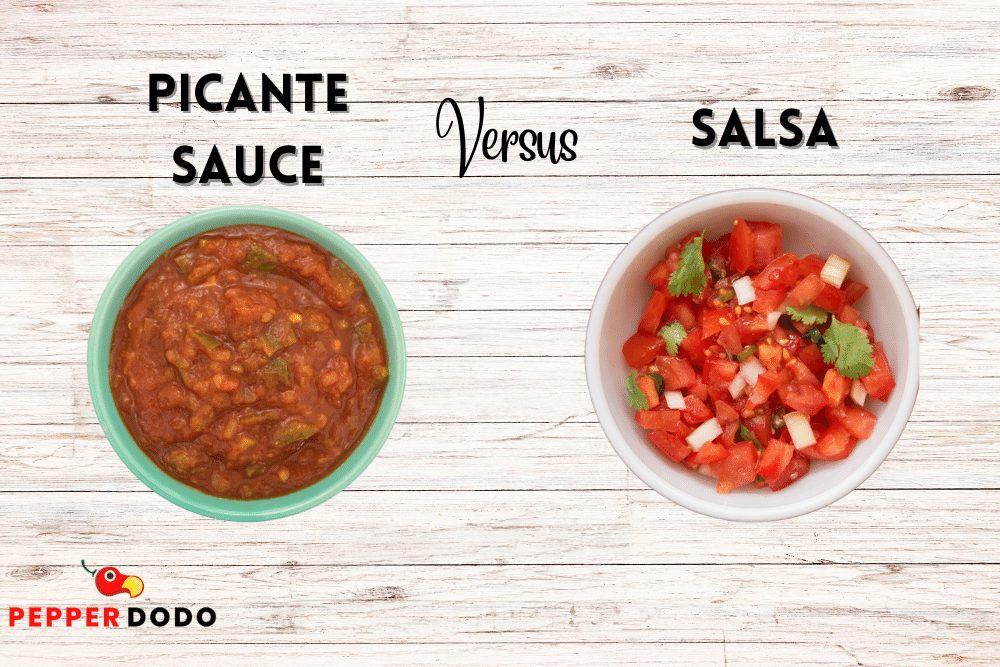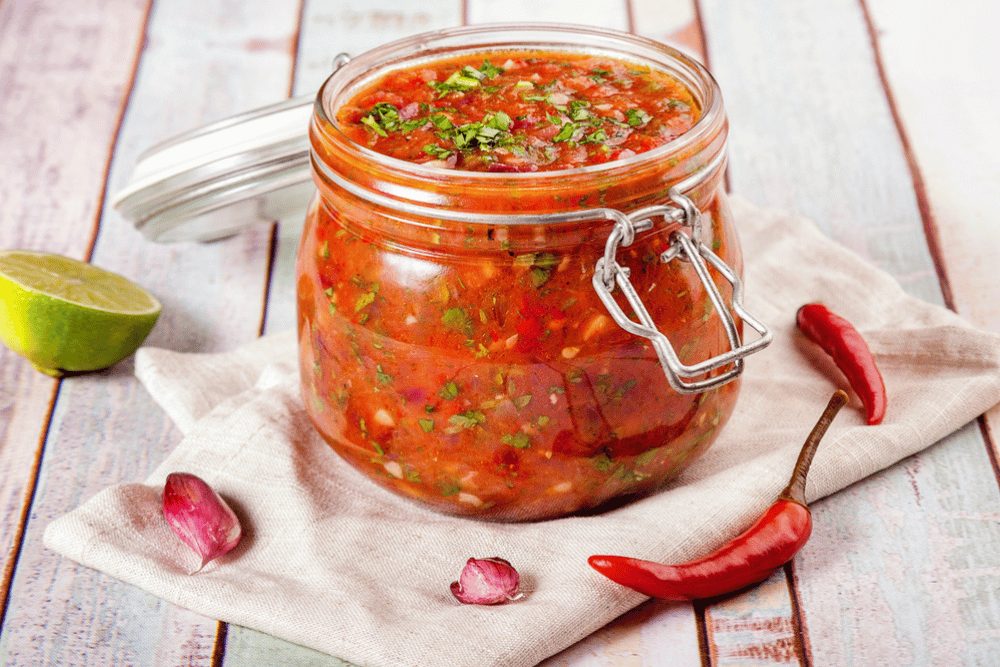Picante sauce translates to "spicy sauce." It refers to a cooked, spicy, thinner version of the common ingredients in salsa: tomatoes, onions, peppers, and other spices. Picante describes the sauce's flavor, but many incorrect assumptions are made about this common Mexican condiment that’s often confused with salsa.
What Is Picante Sauce?
Many immediately hear the term picante sauce and think about the commercially produced and bottled sauce we see on store shelves. But it’s a mistake to believe that the origin story of picante sauce begins with the popular product found in grocery stores.
As far back as the Incas, Aztecs, and Mayans, people were combining tomatoes, peppers, onions, and spices to create a sauce for meat dishes – this is what’s become known as salsa. Over the centuries, this combination has been tweaked, and different versions and recipes have emerged.
Salsa is generally chunkier, thicker, and often fresh.
On the other hand, picante sauce translates to “spicy sauce.” It refers to a thinner, more blended version of these common ingredients that are cooked down. Picante describes the sauce’s flavor; what’s more, picante sauce doesn’t have to be red.

What Are The Ingredients In Picante Sauce?
Although the recipes can vary, all picante sauces contain common ingredients:
- Tomato or tomatillos
- Onion
- Peppers
- Spices
The quantities and types of these ingredients can change depending on the desired result. Some picante sauces are indeed picante (hot), while others are much milder.
How Spicy Is Picante Sauce?
The spice level in a picante sauce depends entirely on the type of chili being used.
For instance, using jalapenos will produce medium heat, whereas chipotle (smoked jalapenos) will create a more intense, smoky, and spicier sauce. Serrano, cayenne, and tabasco peppers will produce a spicier sauce.
When buying off the shelf, there is generally an indication on the label of the heat level. When making your own, you can control the spice level by the chilis you choose and the quantities you use.
What’s The Difference Between Picante Sauce And Salsa? Salsa Roja? Ranchero Sauce?
The world of salsas and hot sauces can get highly confusing. There are various colors, consistencies, heat levels, and uses.
Let’s clarify some of the most commonly used and popular sauces available.
- Picante sauce. Picante sauce is typically a blended combination of ingredients. Sometimes there will be chunks of onion or finely diced tomatoes or peppers, but equally as often, it will be smooth. Picante sauce can also be made with tomatillos rather than tomatoes. This will create green (verde) sauce with a slightly different flavor profile. Think of it like a hot sauce that can be drizzled rather than a thicker sauce or dip.
- Salsa. Salsa is typically chunky and served fresh. You often find a salsa served with tortilla chips or used to top tacos.
- Salsa Roja. Salsa roja means “red sauce.” It’s typically cooked and blended and contains the same essential ingredients as the others, but it tends to be thicker than a picante sauce because it’s cooked down.
- Ranchero sauce. Ranchero sauce is a thicker tomato-based sauce that utilizes spices like cumin, chili powder, garlic cloves, and chipotle chilis. This thick sauce is rich and smokey and an excellent choice for dishes like huevos rancheros or enchiladas.
What To Eat With Picante Sauce
Picante sauce is highly versatile. It can easily be used as a dipping sauce, but most of the time, it’s also thin enough to drizzle on top of tacos or burritos.
Anywhere you need a bit of flavor is a good place for picante sauce.
Is Pace Picante Sauce Authentic?
Pace is a brand of commercially made picante sauce. It was developed in 1947 by David Pace, whose family owned a syrup business.
After being discharged from the military, Pace settled in San Antonio, Texas, and began his own business making syrups, jams, and jellies. In 1947 he expanded into Mexican sauce, which he dubbed the “syrup of the southwest.”
Once Pace perfected his recipe, he called it picante (spicy) sauce and began to bottle and market it. The recipe he developed in 1947 is the same one in use today.
So, is Pace Picante authentic picante sauce?
Yes, more or less. The ingredients are all there, and it’s undoubtedly flavorful. Still, it’s also massed produced and utilizes things like dehydrated onions and refined sugar – ingredients that wouldn’t typically be found in authentic, homemade picante sauce.
Pace Picante sauce is now distributed worldwide and can be easily found in almost any grocery store.
How To Make Homemade Picante Sauce
The great thing about making your own is that you can customize the heat and consistency to suit your tastes.
Most recipes will call for a combination of cooked ingredients like tomato and onion and fresh ingredients like cilantro, jalapeno, serrano, or any other hot peppers you enjoy.
The benefit of making your own is controlling the ingredients’ quality. When compared to other condiments, picante sauce is a nutritionally wise choice. Most picante sauces allow for generous serving sizes that remain low in calories, gluten-free, cholesterol free, and contain calcium and potassium.
When making your own, the natural flavoring of the spices and ingredients also means there’s no need for artificial flavors or additives.
When purchasing store-bought picante sauce, you should check the nutritional information for any allergens or preservatives you’re trying to avoid.
If you’re a fan Pace Picante but want to try your hand at your homemade version, try this copycat recipe.
Print
Picante Sauce
Description
Try this copycat Pace Picante Sauce recipe at home!
Ingredients
1 (28 oz) can of tomato sauce
28oz water
1 yellow onion, finely minced
2 fresh jalapeno peppers, finely minced (to taste, may also use bell pepper, serrano, or other green pepper)
1/4 cup white vinegar
1 teaspoon salt
1 tablespoon dehydrated onion flakes
1/2 teaspoon garlic powder
2 tablespoons finely chopped cilantro (optional)
Instructions
- Place all ingredients in a saucepan and bring to a simmer over medium-high heat.
- Reduce the heat, and simmer for about 30 minutes or until the sauce has thickened.
- Let cool and store in an airtight jar in the refrigerator.
- For a smoother, thinner sauce, blend all or some of the sauce before storing.
Substitutes For Picante Sauce
You’ve got options if you need a quick substitute for picante sauce.
- Salsa. There are wide varieties of salsa, but they all contain similar ingredients to picante sauce and can make a decent substitute.
- Pico de Gallo. This fresh and chunky salsa is delicious but can prove precarious on hand-held foods.
- Enchilada sauce. Enchilada sauce will have a thin consistency, but the flavor is often a little smokier than most picante sauces.
- Tomato sauce. Add some dashes of pepper sauce and a little salt, and voilà, you have a make-shift picante sauce.

